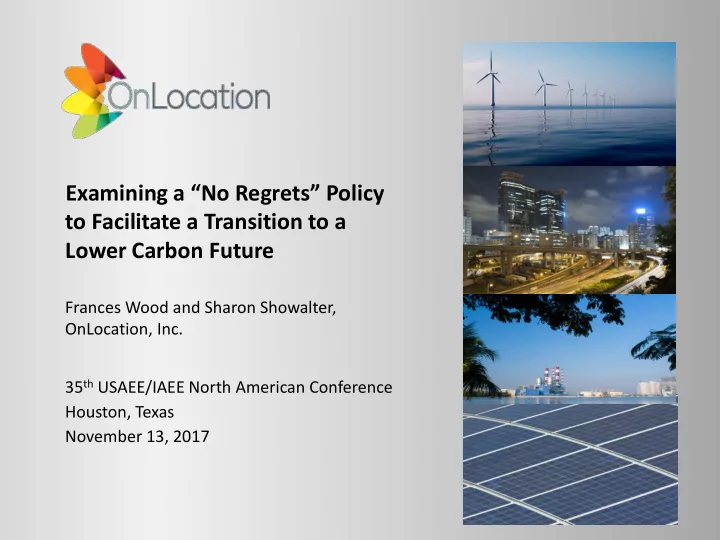

Examining a “No Regrets” Policy to Facilitate a Transition to a Lower Carbon Future Frances Wood and Sharon Showalter, OnLocation, Inc. 35 th USAEE/IAEE North American Conference Houston, Texas November 13, 2017 1
Overview • Study objective • NEMS Overview • CTUS methodology • Scenarios • Results 2
Objective • Examine the potential of carbon capture and storage (CCS) at power plants to provide CO 2 for enhanced oil recovery (EOR) – How much CO 2 could be sequestered? – What are the impacts on CCS and EOR of a sequestration tax credit policy? – How do lower shale resources and higher natural gas prices affect CCS adoption and EOR production? – How might lower cost of capture increase CCS and affect EOR? 3
NEMS Overview • The National Energy Modeling System (NEMS) was developed by EIA – Annual Energy Outlook projections – Congressional as well as agency requests • NEMS has also been used extensively outside of EIA – DOE Policy Office – Program offices within DOE for R&D benefits estimation – Various non-governmental organizations • OnLocation maintains several versions of National Energy Modeling System (NEMS) and works with EIA and others to enhance the model • NEMS performs an annual simulation stepping through time • Modular structure allows each sector to be represented by methodology and data that fit it best – Optimization techniques used for electricity capacity expansion and dispatch and petroleum refining – Extensive technology representation in most sectors 4
CTUS Methodology • The representation of carbon capture, transport, utilization and storage (CTUS) spans several models within NEMS LFMM Cost of transport • Potential Revenue Costof Storage Competitive Stream from EOR Marketfor CO 2 • CO 2 Supplied by CTL to each OGSM Region • Price of CO 2 From CTL to each OGSM Region • Competing Prices for • Pipeline Infrastructure Industrial CO 2 Capture CO 2 By Source to Support CO 2 Flows -by individual site • Available CO 2 By Source • Cost of transport from aggregated into source to sinks (EOR • Demand for CO 2 By EOR P and Q CO 2 forEOR CO 2 captured for EOR and/or Storage quantity and price and/or Saline Storage) bins for each OGSM • Cost of Saline Storage region OGSM CTUS EMM • Potential Revenue Stream from EOR • CO2 Supplied by Gen Competitive Units to each OGSM Marketfor CO 2 Cost of transport Region Costof Storage • Price of CO 2 From Gen Units to each OGSM Region 5
Scenarios • Reference Case ( Reference ) modified from the AEO2017 reference case to include high economic growth and electricity demand and favorable EOR cost assumptions • Tax Credit Policy ( Policy ) includes a tax credit of $35/ton for CO2 captured and used for EOR and a $50/ton credit for CO2 sequestered in geologic storage • Low Oil and Gas Resources ( LR + Policy ) includes the same policy along with lower oil and gas shale resources and technology improvements • Combined Optimistic Low Cost and Policy ( Opt Policy ) assumes roughly 20 percent lower coal CCS costs than the reference case 6
CO 2 Sequestered From Power Plants • Providing a subsidy for sequestration leads to considerable capture of CO 2 from power plants, especially under favorable CCS cost assumptions. 7
Sequestration Sinks • Initially captured CO 2 is used primarily for EOR production, but, over the long run and when a large amount is captured, saline geologic storage is used. 8
CO 2 EOR Production • EOR production expands with the availability of greater, low cost CO 2 sources. 9
CO 2 Purchased for EOR • As the tax credit stimulates more capture from power plants and industrial sources, most of the CO 2 is provided by power plants and CO 2 from natural sources is no longer needed. 10
Conclusions • Significant amounts of CO 2 could be sequestered economically from power plants CCS under some market and policy conditions. – Initially, available CO 2 stimulates additional EOR production, while over the long-term and at high volumes CO 2 is sequestered in saline formations. • A sequestration tax credit is successful at stimulating CCS investment • Higher natural gas prices and lower CCS costs also stimulate more CCS 11
Recommend
More recommend